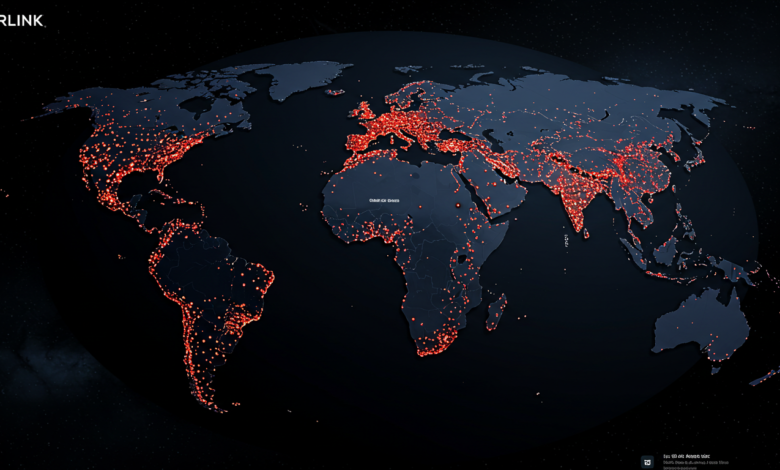“Starlink Outage Map”

H2: Introduction
-
Explain what a Starlink outage map is
-
Why users search for “Starlink outage map”
H2: What Is the Starlink Outage Map?
H3: Sources like Downdetector, StatusGator, ThousandEyes
H3: Why SpaceX doesn’t publish an official map
H2: Major Outage Cases
H3: July 24, 2025 global outage (2.5‑hour event)
H3: May 29, 2024 brief worldwide outage (~45 minutes)
H2: How Users Track Outages in Real Time
H3: Crowdsourced platforms: Downdetector, StatusGator
H3: Social platforms: Reddit r/Starlink reports
H3: Monitoring tools: ThousandEyes Internet Insights
H2: What the Outage Maps Reveal
H3: Geographic patterns (US, Europe, Australia)
H3: Duration heat‑maps, user‑report volumes
H3: Technical causes based on map data
H2: Behind the Scenes — Root Causes of Starlink Outages
-
Software failure vs routing configuration error
-
Impact of solar storms, hardware glitches, jamming
H2: User Experience Insights from Community Reports
H3: Reddit anecdotes and quotes
H3: Case study: Idaho, Texas, Australia outages
H3: Troubleshooting tips and user‑led fixes
H2: System Reliability vs Satellite Limits
H3: Weather, obstructions, power instability
H3: Effect of terrain, cloud cover, interference
H3: Insights from academic measurements
H2: Implications of Starlink Outage Map for Users
H3: Planning home and business use
H3: Military and critical communication reliance
H3: Limitations of crowdsourced reports
H2: How Starlink Is Responding and Improving
H3: Software patches and resilience upgrades
H3: Expansion of network, ground stations
H3: Transparency and communication around outages
H2: Tips to Stay Connected During an Outage
-
App diagnostics, cache reset, power backup
-
Use of UPS, re-align dish, check cable connections
H2: Future of Outage Mapping for Satellite ISPs
-
Call for official tools and dashboards
-
Learning from terrestrial ISPs
H2: Conclusion
-
Recap importance and insights from outage maps
-
Final note and label: Main Keyword: Starlink outage map
Introduction
If your internet goes down and you use Starlink, you may wonder: “Is there a Starlink outage map?” Many users search for “Starlink outage map” to track disruptions in their area. They want confirmation, timelines, and patterns.You know about theglobespot, andaazdaily, openrendz and starlink outage map also Buzzfeed.
Starlink does not publish its own outage map. Instead, platforms like Downdetector, StatusGator, and ThousandEyes offer global status visuals based on user reports or active probing. These maps work like heat maps. They highlight regions with high outage reports in real time. They fill the gap left by the lack of a public Starlink dashboard.
Consider two major case studies. First, on July 24, 2025, a global outage struck around 19:15 UTC and lasted about 2.5 hours. Pocket outages appeared in the U.S., Europe, and Australia. Reports peaked at over 60,000 users, according to survey data and Reuters analysis. Service restored by around 21:40 UTC (ThousandEyes) FingerLakes1+5ThousandEyes+5ABC+5RedditReddit+2HighSpeedInternet.com+2Reddit+2. Second, a shorter 45-minute outage on May 29, 2024, also hit users globally. Analysts linked it to DNS timeouts and network reachability failure ThousandEyes+1ThousandEyes+1.
Meanwhile, users often post real‑time reports via Reddit in r/Starlink. They mention outages in Texas, California, Alberta, Germany, Australia, and beyond. As one user wrote, “Out in Southern Utah… still down.” Others reported return of service after brief intervals Reddit. These combined data points form the crowdsourced outage map that many rely on.
Moreover, outage maps reveal more than timing. They display geographic distribution, outage duration, and report concentration. From that data, experts deduce possible causes—such as internal software misconfiguration, DNS failures, or control-plane disruptions. For example, July’s outage was traced to a software network failure in Starlink’s core infrastructure ThousandEyes+2Investing.com+2Reddit+2.
In addition, academic research shows other outage drivers: solar storms can degrade throughput and cause short drops. Likewise, terrain obstruction or power surges can interrupt service locally arxiv.org.
This article dives deeper. You’ll learn how outage maps work. You’ll see real examples and map visuals. You’ll explore user‑reported feedback. You’ll get insights into how Starlink is addressing resilience. And you’ll find practical advice for managing connectivity when maps signal a problem.



